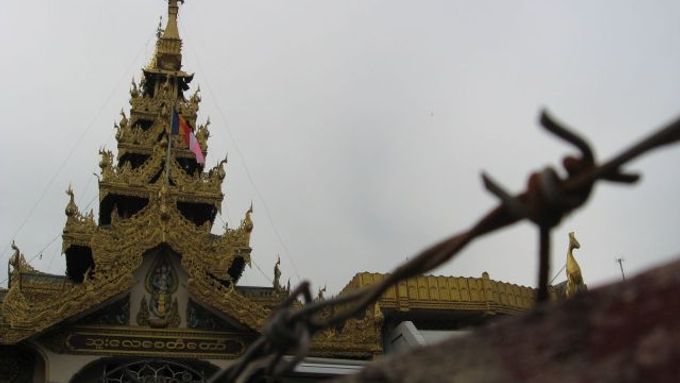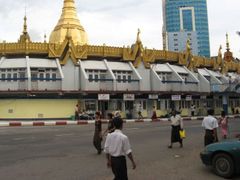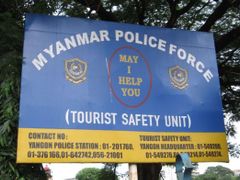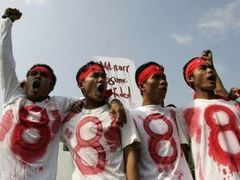Yangon - "This whole area was crowded with people," says Ko Maung Kyaw with a knowing smile in front of a rapidly aging Yangon (formerly known as Rangoon) city hall. "They came here to call for democracy."
The wooden barriers with a barbed wire which are stacked in rows all over this central square encompassing the city hall and nearby Sule Pagoda make his words even harder to believe.
Yet this is exactly what happened on August 8 1988 when Burmese capital experienced the biggest pro-democracy public gathering to this date. True to the local tradition in this military regime-run country, the events were to end in a blood-bath once again.
Karaoke with a taste of blood
"Shortly before midnight, the military units which were called to the city, sealed off the square," recalls another participant of the student rallies from 1988 Win Minn. "Then suddenly the street lights went off and with the military searchlights scouring the air machine gun fire started. Straight into the crowds."
We sit in a closed room of a fancy karaoke palace some ten minutes of driving from the places where 19 years ago people trapped by the army dropped like flies to the ground.
One nice feature of these karaoke-bars with a little bit of privacy is that you can discuss things here which are otherwise a strict taboo in Burma.
Both of the former students spent time in jail, being perceived as enemies of the state. One served three and a half years, the other nearly 16.
But in those August days of 1988 they could not have guessed what was in store for them. Not experiencing other than the military type of government in their lifetime, they succumbed to the momentary feeling of optimism and hope for a better future after two previous waves of student demonstrations in March and June that year which echoed surprisingly strongly throughout the country.
The date for the biggest anti-regime mass action had been chosen in advance and it had something of a magical ring to it: 8-8-88. It meant to send a clear message to the powerful general Ne Win whose well-known obsession with number nine found expression for example in the introduction of not-exactly-round 45-kyat bills.
Amputating like mad
Ko Maung Kyaw was to learn about the shooting in the city centre very soon. As a student of dentistry he had many friends among medics and they called him to help in the emergency room of Rangoon General Hospital as soon as the military trucks started unloading the bloodied bodies of demonstrants.
"We were working non-stop in shifts. No explanations were needed, the gunshot wounds were obvious. The intake of patiens was so overwhelming we had to amputate like mad. Nurses and doctors were crying, but there was nothing else we could do," he describes in horrifying details what has been etched forever in his memory.
"Later I also saw dead bodies. When called to a morgue because of some death certificate, I could glimpse piles and piles of bodies, some of them in monk robes and also many women."
Paradoxically, there were to be victims even among the staff of the hospital itself. Since the protests continued despite the brutal reaction of the military and more people were being killed, the medical workers went out into the streets calling for the end to the bloodshed. Instead, their white robes were to turn red as well.
Enter Suu Kyi
Shooting at the demonstrating medics only served to reinvigorate the public outrage. On the flat roof of the hospital´s one-story emergency room unit a stage was set up with prominent lawyers, actors and other public faces taking turns at the microphone, recall Ko Maung Kyaw and Win Minn.
Daughter of the revered national hero from the times of the struggle for independence Aung San Suu Kyi made her public debut at one such rally, calling the demonstrations a beginning of another fight for Burmese independence and urging government to negotiate.
Seeing the pressure mount instead of decreasing the generals made their first moves, changing the government´s top leadership and sending the first reluctant feelers towards the other side.
By that time though, the demands of the protesting public grew much bolder. Nothing short of complete return to democracy from before 1962 could stop the storm.
So you want democracy?
However, the hardliners were far from ready for that, unleashing a coup d´etat instead in the mid-September. It is believed the now officially retired general Ne Win was its real mastermind, thus repeating the old trick from quarter of a century ago.
"It ended the same way it began with shooting into the crowds. The massacres went on for three days. Then it was over. Part of the students fled to the mountains where they joined the rebels from the ethnic minorities while another part was waiting to see if the new leader, general Saw Maung, would keep his promise to hold a democratic multi-party elections," explains the former student leader Win Minn who first met Ko Maung Kyaw as they were chained together on a prisoner transport train from Rangoon to Mandalay.
The promised elections did take place - in May 1990. It was the first democratic vote in three decades in Burma and the opposition National League for Democracy led by Aung San Suu Kyi defeated the military-backed National Unity Party in a landslide.
But the new parliament was never allowed to convene and for the now famous daughter of general Aung San a personal martyrdom began with the perpetual cycle of arrests and detentions only occasionally broken by the brief periods of freedom, however imperfect in a country run by a reckless military junta which insists on retaining the leading role even when it comes to things like transition to democracy.











